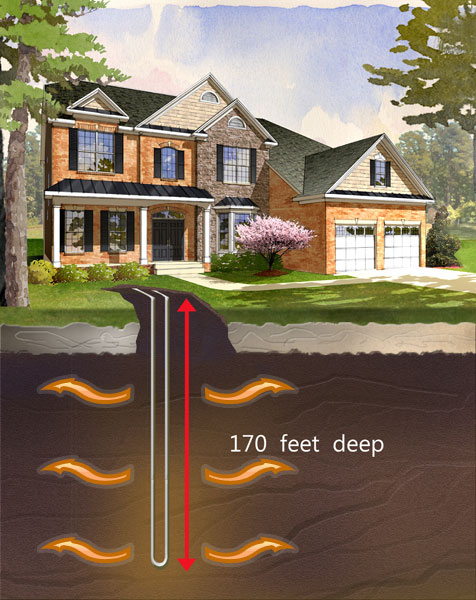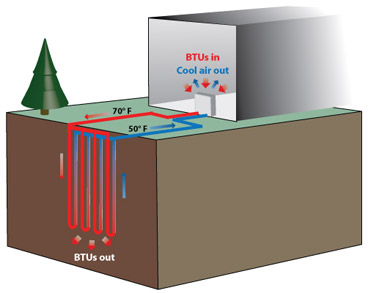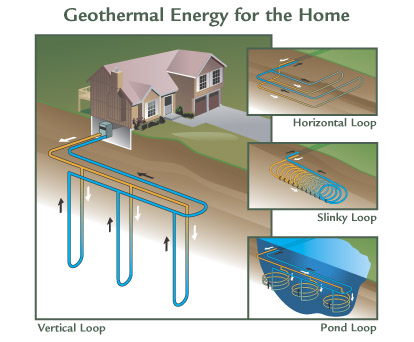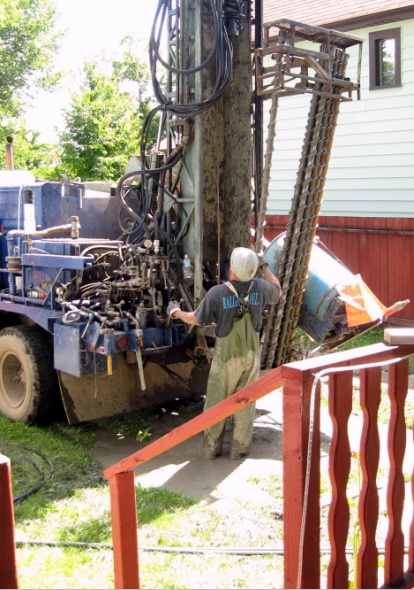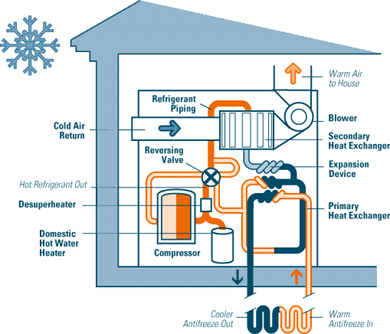|
|
|||||||||||||||||||||||||||||||
|
Geothermal Heating Systems
Introduction by Charles Moffat - 2009. When some people think of geothermal they think of harnessing the power of volcanoes, drilling holes in the Earth's crust and pouring water in to create a steam vent to turn a generator. Technically such things are possible, but they're also largely unnecessary. A lot of heat can actually be derived just by drilling down a little and using nothing more than air circulation to get heat. Hence the marvel of geothermal heating systems, a growing trend amongst home-owners. My sister and her husband are thinking of buying a geothermal heating system for their home. Price estimates vary, but thanks to incentives by the Ontario and Canadian governments they will be able to get one for relatively little and save a bundle on future heating bills. Pending their success my parents and other family members may follow suit. They're not hippies either. They just like to save money and have clued in that their heating bills could be a lot lower if they made the investment. (This article may be updated later after they install and see the results.)
How Does It Work?
Geothermal heating systems (also known as ground source heat pumps, GSHPs, earth energy, or geoexchange systems) are an ideal way of reducing home energy costs. These systems are incredibly environmentally friendly as it uses the natural heat of the Earth with no emissions or toxicity involved. A series of pipes are drilled down into the ground to create a circuit. Air is then pumped through the circuit using a small electric fan (so there is technically a small amount of energy used to make the system work). The circulating air goes down into the ground cool and comes up warm. This is a similar concept to building your home in a deep cave, where the air temperature is constant all year long, but without the obvious problems of living inside a cave. They can be combined with radiators but it is thought that under-floor heating works best, as it uses a lower temperature. In the summer the system can also be used like an air conditioner to pump cool air into the house. The same pipes can also be used to heat water for home use.
Choosing a Vertical or Horizontal System
When choosing a heating system there are four common loop systems - vertical, horizontal, slinky and pond. A vertical closed loop field is made of up vertical pipes in the ground, in a hole usually 150 to 300 feet deep. Here the pipes are joined by a U-shaped cross connector at the bottom of the hole. In comparison a horizontal closed loop field is composed of pipes that run horizontally in the ground and run 400 to 600 feet long, where U-shaped coils are placed horizontally inside the trench. Horizontal loop fields are very common and economical if there is plenty of adequate land available. A slinky closed loop field has pipes which overlay each other, whereas a closed pond loop is attached to a frame and located in a body of water.
The Benefits of Geothermal
GSHPs are also a great way of decreasing domestic costs such as home insurance because they help reduce building insurance premiums. Home insurance costs and contents insurance benefit from geothermal systems too because it is low maintenance as there are no hazardous gas emissions or flammable oils. There is no need for regular servicing or yearly safety checks either. Quiet operation with no noisy outdoor units means a less disturbing atmosphere for both neighbours and the environment. There are also government grants available for the installation of a domestic ground source heat pump. Check out what your local provincial, state or federal government is doing to see if you're eligible for a grant, tax refund and/or incentive. However, despite all the advantages, there are problems with the product. For a horizontal system a household will need space to lay the pipe system down in trenches, and for a three bedroom house that means 2x50 metre long dugouts, therefore it is not ideal for dense suburban neighbourhoods, meaning homeowners may have to get a more expensive vertical system which requires drilling deeper. Another problematic issue is the efficiency of a heat-pump system, which needs insulation to work, thus making under floor heating in old or badly insulated houses unpractical. However, a major selling point of geothermal heating system is that they reduce heating and cooling costs by about 50% and usually cost between $10,000 and $20,000 USD. The heating systems are usually eligible for most state, federal and utility credits and encouragements. The financial rebates and savings of the heating product is also rewarding for the more environmentally friendly homeowner. The rebate programme and the ensuing installation of heat pumps would cut an average four metric tons of carbon emissions per year per unit, due to high energy efficiency of geothermal heat pump technology. “If you multiply those reductions by the average unit life of 24.4 years, that means 97.6 metric tons of emissions could be eliminated over the lifetime of each unit, and 234,240 tons over the lifetime of the 2,400 units sold through the rebate program.” - Bruce Ritchey, CEO of the geothermal heating system manufacturer WaterFurnace.
Geothermal Energy in the USAIn an attempt to help the United States gain control of the economy, create jobs and save energy, President Barack Obama signed in February 2009 a federal Economic Stimulus Package, which focuses on renewable energy sources.
President Obama has spoken frequently on energy matters, including during the 2008 Presidential debate with John McCain on October 15th, 2008 when he said: “We can't drill our way out of the problem. That's why I've focused on putting resources into solar, wind, biodiesel, geothermal.” The White House believes that by making low interest loans available, it could generate at least an extra 200 heat pumps sales per month and kickstart a trend towards more geothermal energy. Bruce Ritchey, CEO of the geothermal heating system manufacturer WaterFurnace, says the new bill will be a huge advantage to the country: “Every state should take at least five percent of the funding available through the energy efficiency portion of the stimulus package and invest it in a geothermal incentive. I can't think of a faster, more cost effective, greener way to put people back to work, save fossil fuel, reduce carbon emissions and save homeowners thousands of dollars per year for the next 24 years. It's the stimulus that keeps on stimulating.” There are many advocates for such an energy saving product and Ritchey is at the forefront of such an environmental campaign, concluding: “Every state should invest it in a geothermal incentive. I can't think of a faster, more cost effective, greener way to put people back to work, save fossil fuel, reduce carbon emissions and save homeowners thousands of dollars per year for the next 24 years. It's the stimulus that keeps on stimulating.”
Geothermal Energy in Canada
Sales of energy-saving geothermal systems that heat and cool buildings are booming in Ontario, thanks to generous government incentives and concern over rising fuel and electricity prices. But the industry is warning homeowners and municipal governments to beware of fly-by-night contractors who falsely claim they're qualified to do installations and is urging homeowners to check whether its a government approved system that is elligible for grants. "We are asking everybody to keep their antennas up," said Ted Kantrowitz, vice-president of business development at the Canadian GeoExchange Coalition. "The market is growing so quickly that there's a lot of room for people to be misinformed." In Canada we use a lot of energy to heat our homes during the winter so the savings is much larger. A home that converts to geothermal from oil or electric heating can cut annual heating and cooling costs by up to 70%. But at a cost of about $20,000 to $25,000 CDN for a typical household, an unqualified installer can turn a well-meaning project into a nightmare. Kantrowitz says there are well over 40,000 geothermal systems already installed across Canada, with the industry enjoying a record growth rate of between 45 and 55% – outpacing even the United States. "It's a phenomenal number, especially if you keep in mind that it's only for retrofits, and only retrofits that have applied for government incentives." The fastest growth has been in Ontario, which has seen about 1,500 installations since April 2008. The next closest is Quebec, with just under 300 installations. Manitoba and Saskatchewan are ranked at the top on a per-capita basis. But many unqualified contractors are trying to ride on the coattails of that growth, he says. The association has received a number of complaints about contractors "promising the moon" but not delivering or doing sloppy work. Many homeowners are getting systems that don't meet standards and codes, aren't compliant with local bylaws, don't qualify for rebates, or fail to achieve promised energy savings. The first hint is if the sales agent is high pressure and rarely shows any government documents or approvals. The industry has created training and accreditation programs, which require contractors to follow an industry code of conduct and accredited installers or designers must provide consumers with a special identification card bearing their registration number. Kantrowitz said the new standards, training and accreditation programs are helping to keep "bad seeds" out of the market, but the fast growth requires more vigilance than ever. "It has been improving, but we're still working, particularly as the home heating season approaches." Only consumers who use accredited contractors qualify for government incentives – $3,500 under the federal rebate program, which is matched by the Ontario government for a total of $7,000. Ontario also waves the provincial sales tax of 8%, which overall drops the price significantly. "In Canada, the standards put in place are more stringent than anywhere else in the world," says Bruce Ritchey, president and chief executive officer of Fort Wayne, Indiana-based Waterfurnace Renewable Energy Inc., a top seller of geothermal systems that's listed on the Toronto Stock Exchange and made approx. $120 million in sales during 2008. Sales to Canada were "phenomenal," says Ritchey, attributing the growth to strong government incentives, a healthier economy, and increased awareness about geothermal. "Canadian sales were up 119 per cent versus the same quarter last year," he says. "Ontario has grown the most. It's up 200 per cent."
|
|
||||||||||||||||||||||||||||||
|
Website Design + SEO by designSEO.ca ~ Owned + Edited by Suzanne MacNevin | |||||||||||||||||||||||||||||||
